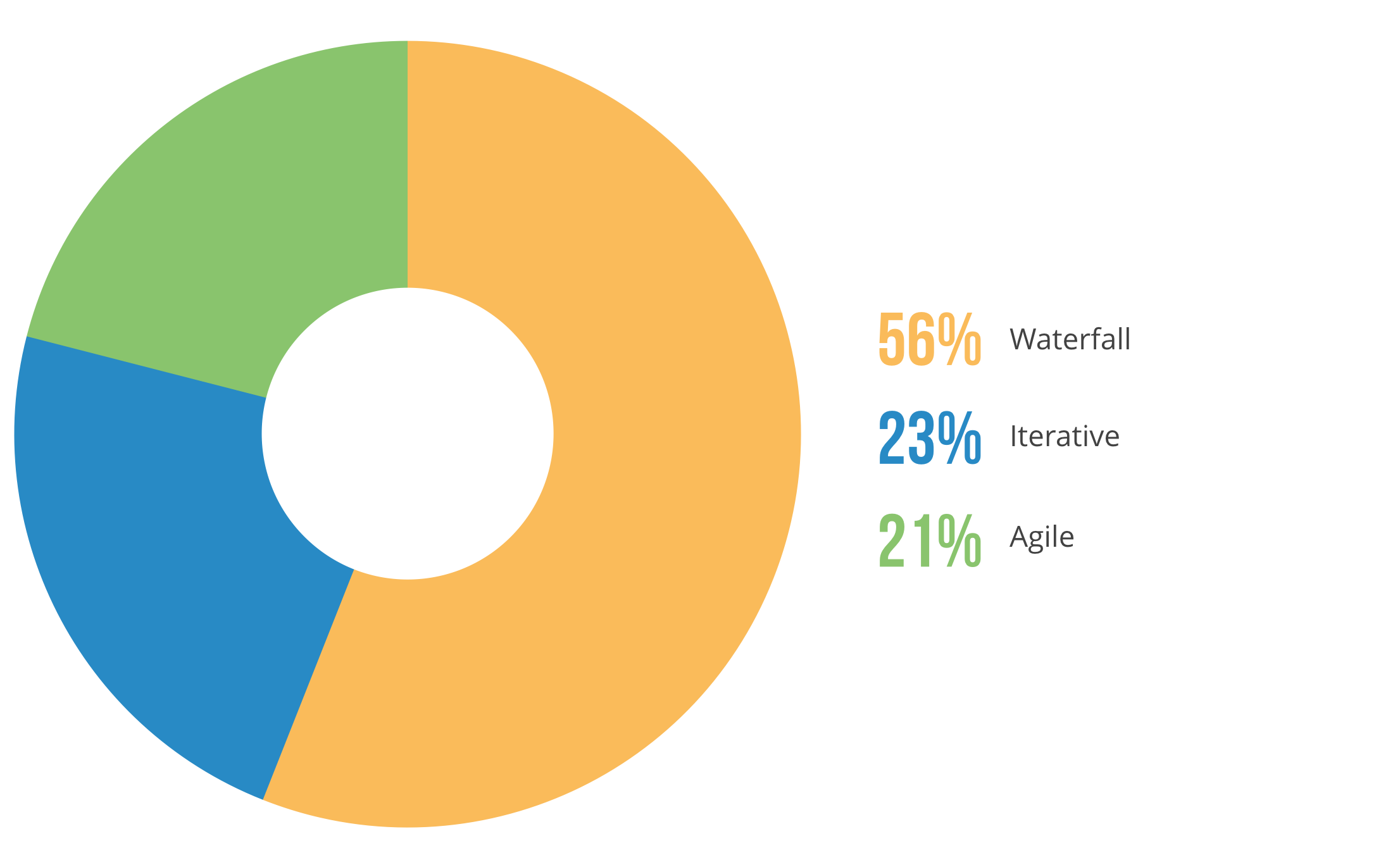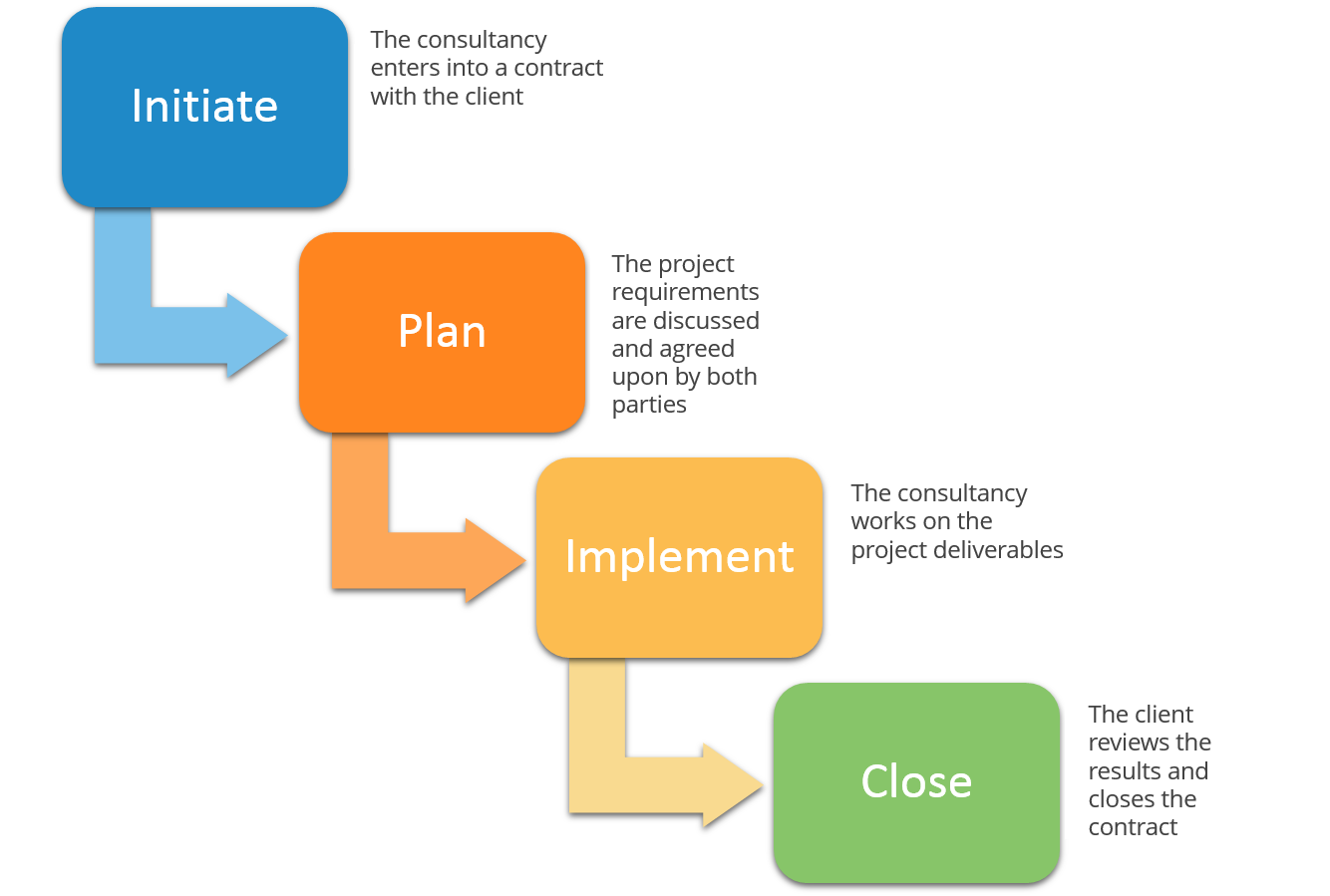Q&A: How to Use Waterfall Project Management at Your Small Business
Conventional wisdom says the rise of agile project management methodologies has caused many companies to eschew waterfall project management. A Google Trends report suggests as much:
Popularity of Agile Project Management vs. Waterfall Project Management

(Google Trends: 2004-2017)
Does this mean that waterfall as a project management methodology is finally dead? No!
According to a Gartner report (content available to clients only), “waterfall methods were employed on 56 percent of development efforts in 2015.”
Project Management Methods Used in 2015

(Source: Gartner)
The data is compelling, but the Gartner study focuses on enterprise businesses. We’re left wondering: Is the waterfall model still a viable option for small to midsize businesses (SMBs)?
 In this report, we’ll answer that question by speaking with an expert. Dr. Mike O’Callaghan (PhD, MBL, PMP), is a project management specialist and coach at Relevant International. He has worked as a project manager with companies such as Engen, Shell and Old Mutual.
In this report, we’ll answer that question by speaking with an expert. Dr. Mike O’Callaghan (PhD, MBL, PMP), is a project management specialist and coach at Relevant International. He has worked as a project manager with companies such as Engen, Shell and Old Mutual.
As an expert in his field, he has developed and implemented project management methodologies for different departments as well as trained staff on following those methodologies.
Before we get into the Q&A, here’s a quick explanation of waterfall project management methodology:
Within the waterfall project management methodology, projects move along a linear and defined trajectory, like water gushing down a waterfall. It begins with planning, where project requirements, scope, budget and task timelines are discussed and fixed. Then comes the execution, where success is measured on how closely the project outcomes match the initial requirements.
Here’s a visual representation of what a waterfall process for a small consultancy could look like:

Q: Why should SMBs opt for a waterfall methodology?
ANSWER: While setting-up a project management process for client-based organizations (an example would be a small consultancy firm offering services to a client), I realized that it was far easier to put a structured, waterfall-type project management process in place than an agile one.
Agile is suitable for internal projects of a small company, where different teams compete for resources, as managing resources with short-phased projects is easier. But using agile project management processes to match with a client’s expectations is an upward task.
In agile project management, changes to the project deliverables are expected and accepted as part of the process. However, a small business working with a client cannot afford project outcomes to change drastically. This is because they sign a contract and then deliver against it. Essentially, it means that when the client wants X, then you have to deliver X.
Instead, the waterfall model is much more suitable, when one works with a client that expects the fixed deliverables to be met as contracted.
Additionally, a waterfall type project can be structured into a process, which means the consultants don’t need training to manage the projects. They simply follow a predetermined process. Whereas an agile structure would require experienced project managers as consultants cannot manage the projects without undergoing training.
Key takeaways for small businesses:
Waterfall could be suitable for projects with fixed requirements. A waterfall model is “change-averse” and project outcomes have to closely match the expectations laid out during the planning phase.
Waterfall might not be suitable for resource-crunched companies. Instead an agile project management process, such as Kanban, might allow organizations to work within the constraints of time and costs by completing projects in incremental phases.
That said, there are many risks associated with agile projects. To get a better understanding of the risks and ways to overcome them read our report on how to prepare your SMB for a transition to agile processes.
Q: How do SMBs use the waterfall model? What are the risks?
ANSWER: An example that comes to my mind is of a health and safety consultant—a small company that provided consultation to large companies. A waterfall project management process for such an organization would have the following stages:
Initiate: This would involve contracting with the clients, the legals and the commercials, such as the sales and set-up aspects of the business.
Planning: It would consist of the development documents, essentially analyzing the client’s business environment, reviewing the health and safety requirements, comparing them to the legal situation and so forth.
Delivery/Implementation: This includes documentation for the clients such as health and safety regulations. Then the implementation, which is essentially the training of the client’s health and safety officers.
Closure: The final review and closing down the contract.
That said, a small company faces different risks when implementing a waterfall project management process. Here are some of the common challenges:
Planning time: You promise the client to complete the project in 3 months. The first thing the client would do is look at their risk profile and choose either a time-based or fixed-delivery based contract. Now, if they have a fixed-delivery contract with you (a small consultancy) and you run over time, then all that costs is to be borne by you. That’s the biggest risk.
Ensuring quality: If you don’t get the quality right then any rework you have to do around the quality that the client wants is at your cost. As a small business any change in cost could affect you severely.
Single contract lock-in: You were unable to get the project plan to a reliable state before actually signing the contract. And you didn’t have a two stage “contracting” process – where the first stage of the contract ends at the planning phase and at the second stage (delivery phase) the client has an option to go somewhere else if they want to. This adds the risks of not getting paid anything if the client is unhappy with you for project delivery.
Key takeaways for small businesses:
Use time-tracking tools for fixed-delivery projects. For simply tracking time, some free tools could come handy. If you need to to bill clients for time spent on a project, then check-out BillQuick, Replicon and Unanet—time and expense tracking tools, rated highly by users at Software Advice.
Ensure quality with resource capacity planning tools. Having the right people on the right projects is key to ensure high-quality deliverable. Using resource capacity planning software, such as Mavenlink, Workfront and Resource Guru, you can analyze employee skill-sets and strategically assign them the relevant projects.
Design secure contracts with project planning tools. Tools like Gantt and PERT charts help you plan projects better, necessary for creating secure contracts with client when initiating the project.
Q: Do project management tools help?
ANSWER: Absolutely, and there are two tools I can recommend, specifically.
One would be a simple project scheduling tool that helps businesses outline a project’s tasks and sub-tasks. Small client-based organizations would need this while drawing up a new contract with a client.
The other is a reporting tool. For example at the end of the project planning phase, the small business needs to send an assessment report telling clients that the first phase is over and they need to create a new contract for the development phase. So wherever there’s a decision making point, we put a reporting tool in place.
Key takeaways for small business:
Use software to help manage projects. Scheduling tools help you avoid project mismanagement and reporting tools give you detailed insights into how your team is delivering.
Conclusion and Next Steps
In this report, we boil down the discussion to a key question: what is your business requirement? And then try to answer that. However, the article does not intend to pigeonhole the discussion, but is rather a deliberate effort at offering small business actionable insight into the waterfall methodology.
That said, a Gartner study, “The End of the Waterfall as We Know It” (content available to clients only), points out that, “traditional waterfall practices result in inconsistent delivery results.” This study was done taking into consideration enterprise IT companies, but the fact is that waterfall project management is still relevant to for SMBs—especially those delivering software to clients.
With software development projects, there are always changes in the interface or at times even functionalities right up to the time the software is developed. In such cases, following a waterfall model with fixed, upfront client requirements and delivering against them might be akin to pushing up the wrong wall.
Interested readers should also check out our articles on agile project management tools for a fuller understanding of the topic: